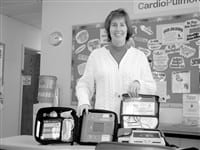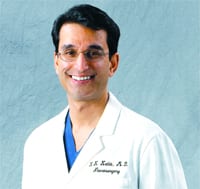Shock To The System Defibrillator Use Not As Widespread As It Should Be, Some Say
Ronald Kidd’s passion for defibrillators has paid big dividends — in lives saved.
After Kidd, an attorney with Robinson, Donovan, P.C. in Springfield, joined the board of the Greater Springfield YMCA, he led a campaign to deploy automated external defibrillators (AEDs) at Y facilities. The agency did exactly that — with dramatic results.
Specifically, in April of 2002, an 81-year-old member was stricken with sudden cardiac arrest (SCA). Y personnel used one of the devices on the woman — well before the arrival of EMTs — and not only did she live, but she walked out of the hospital after only one day. A second life was saved when a cardiac arrest occurred in a swimming pool.
“So we’re two for two,” Kidd told The Healthcare News. Still, such outcomes don’t surprise someone who has participated in a number of lawsuits involving airlines, health clubs, and other facilities surrounding the need for defibrillators as a reasonable, life-saving precaution.
Robinson Donovan became involved in the field in 1996 when it investigated a claim by a longtime client, whose 38-year-old husband had died following sudden cardiac arrest aboard a United Airlines flight a year earlier — a flight on which no defibrillator was available.
That led to a successful lawsuit against United — one of several airline-targeted suits that eventually brought about a federal regulation in 2001 requiring defibrillators and trained operators on all flights that don’t already have them, starting in 2004.
“The survival rate with somebody going into cardiac arrest is about 5{06cf2b9696b159f874511d23dbc893eb1ac83014175ed30550cfff22781411e5}. With CPR and defibrillators, it can increase to 40{06cf2b9696b159f874511d23dbc893eb1ac83014175ed30550cfff22781411e5} or more,” said Cheryl Sabola, a registered nurse and CPR coordinator at Baystate Medical Center. “But we don’t have enough out there to get our numbers really high yet.”
That’s slowly changing, however. Also in 2001, the government issued guidelines requiring all federal buildings to have defibrillators on hand, with training overseen by a medical director — usually a local emergency room doctor or cardiologist, Sabola said.
Meanwhile, other types of facilities, from malls to golf courses to high-rises such as Tower Square in downtown Springfield — where Robinson Donovan is based — are increasingly equipping their staffs with defibrillators and providing training.
Spurred by both medical and legal developments, that’s a trend that has plenty of people breathing easier — and, more importantly, living another day.
Arresting Developments
udden cardiac arrest is not the same thing as a heart attack; instead, it is the abrupt stoppage of the heart’s ability to pump. Victims quickly lose their breath, pulse, and consciousness — and their lives, to the tune of some 250,000 to 350,000 Americans per year.
Many cardiac arrests are due to an abnormal heart rhythm called ventricular fibrillation (VF), during which the heart’s electrical impulses malfunction, causing the heartbeat to short-circuit and pumping to stop.
In arguing the need for defibrillators, Robinson Donovan typically notes that the only effective treatment for VF is rapid defibrillation — within a few minutes of the arrest. Even if CPR is used, if seven minutes pass without defibrillation, the chances for resuscitation grow slim, and even then, neurological damage is likely, due to lack of blood to the brain. And seven minutes is often not enough time for an ambulance to arrive.
Because police often arrive on the scene of a medical emergency before an ambulance, Sabola said, she has been involved with efforts to get local police and fire officials equipped with defibrillators and properly trained.
Defibrillators essentially send an electrical charge into the heart, ending the short circuit and restarting the heart’s natural beat. And many people don’t understand how easy it is to learn to operate the devices, said John Sikorsky, also an attorney with Robinson Donovan. “There is still a little bit of this idea that these are dangerous, but they’re actually idiot-proof,” he said. “You put the pads on, and it won’t give a shock unless it’s needed.”
He cited one study in which a classroom of sixth-graders received five minutes of instruction with defibrillators and, when tested in a mock drill, performed at about 75{06cf2b9696b159f874511d23dbc893eb1ac83014175ed30550cfff22781411e5} of the competency level of trained EMTs. “You just have to know where to put the pads, and it automatically tells you to stand back and hit the but ton if the shock is needed,” Sikorsky said.
“Really, any person could learn how to use them,” Sabola agreed.
And they can learn to use them effectively, Kidd said, noting that O’Hare International Airport in Chicago reports save rates around 75{06cf2b9696b159f874511d23dbc893eb1ac83014175ed30550cfff22781411e5} or 80{06cf2b9696b159f874511d23dbc893eb1ac83014175ed30550cfff22781411e5} since incorporating defibrillators in the terminal buildings themselves.
More health clubs are purchasing defibrillators, Sikorsky noted, although some are still balking. The expense is a factor — the devices cost around $3,000 each — but he and Kidd feel that, as they become more widespread in places where they are required by new laws, the cost will decrease, and more businesses will choose to use them voluntarily.



Comments are closed.